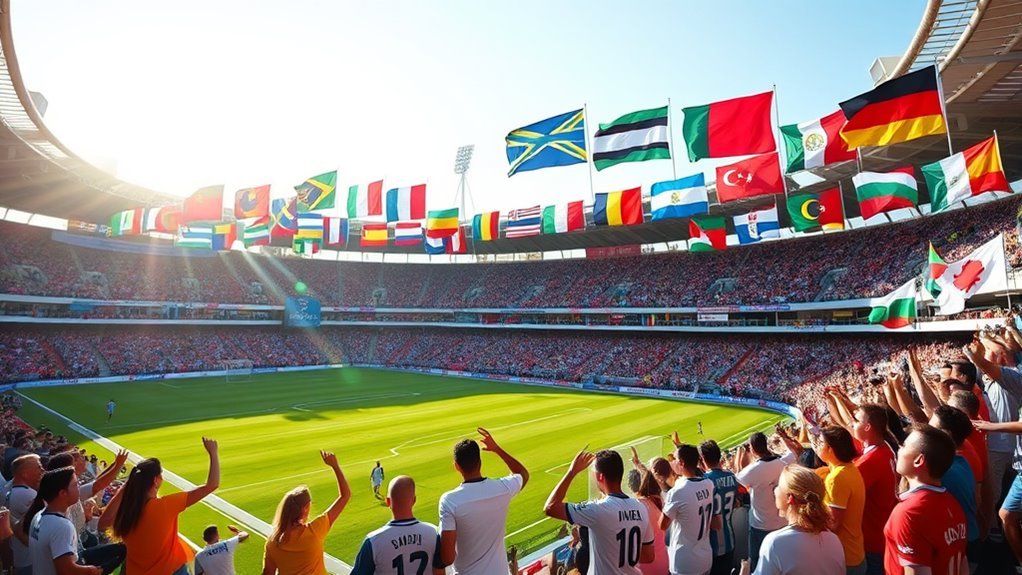India has a real shot at qualifying for the FIFA World Cup 2026. With youth academies blooming and the Indian Super League boosting talent, the landscape is evolving. Historical struggles have turned into promising performances in World Cup qualifiers, thanks to better coaching and player fitness. However, challenges remain, like inconsistent infrastructure and competition from stronger Asian nations. As the national team gains experience, you’ll see what’s needed for success in the upcoming qualifiers.
The Current Landscape of Indian Football
While Indian football has faced numerous challenges, it’s also seen significant growth and potential in recent years. You can feel the energy shifting as youth academies emerge across the nation, nurturing the next generation of talent. These academies are essential; they’re not just about skill development but also about instilling a passion for the game that can lead to greater achievements.
Improving coaching standards is another important piece of the puzzle. With better-trained coaches, players can refine their skills and tactical understanding, which can elevate the overall quality of the game. You’ll notice that these changes are fostering a more competitive spirit among young athletes, pushing them to reach for new heights. Additionally, as athletes work on drills that improve overall agility, they can enhance their performance on the field.
As the landscape evolves, it’s clear that the future of Indian football is promising. If these trends continue, there’s no telling how far the country can go on the international stage.
Historical Performance in World Cup Qualifiers
When you look at India’s historical performance in World Cup qualifiers, you’ll notice a mix of near misses and memorable matches. It’s crucial to analyze those previous attempts and how the current team stacks up against past efforts. Understanding these elements can shed light on India’s chances for FIFA World Cup 2026.
Previous Qualification Attempts
Although India’s football history is rich, its attempts to qualify for the FIFA World Cup have often been challenging. You’ve seen how the team faced tough competition over the years, with many historical matches that showcased their potential but fell short in achieving success. The qualification statistics tell a story of ups and downs, with the team only competing in the World Cup qualifiers since 1950. Despite moments of brilliance, they haven’t made it to the final tournament. Each attempt reflects not just the struggle, but also the hope that keeps fans dreaming of a day when India will finally secure a spot on the world stage. It’s a journey still in progress, and the future holds promise.
Notable Matches Analysis
India’s journey through World Cup qualifiers has been marked by several notable matches that reflect both the team’s potential and the challenges it faces. These matches not only highlight the highs and lows but also provide tactical insights into the team’s evolving strategies.
| Match Date | Opponent |
|---|---|
| 1986 | North Korea |
| 2002 | Iran |
| 2018 | Qatar |
In these encounters, you’ll see how India showcased resilience and skill, even when faced with formidable opponents. Each match serves as a learning experience, shaping the team’s approach for future qualifiers. It’s essential to recognize these moments as stepping stones toward the ultimate goal of securing a spot in the 2026 World Cup.
Current Team Performance
Despite facing numerous challenges over the years, the Indian national football team has shown remarkable growth in its performance during World Cup qualifiers. The current squad, infused with young talent and seasoned players, has embraced effective coaching strategies that enhance their gameplay.
- They’ve considerably improved their tactics.
- Recent matches showcase better teamwork.
- Players are more adaptable under pressure.
- The squad’s fitness levels have noticeably increased.
- Fans are more optimistic about future matches.
With a strong foundation, the team is on the brink of breaking barriers and making a mark on the international stage. If they continue this upward trajectory, you might just witness them qualifying for the FIFA World Cup 2026!
The Role of the Indian Super League
The Indian Super League (ISL) is vital for developing football in India and can greatly impact the national team’s chances of qualifying for the World Cup. With more exposure and opportunities for players, the league fosters talent that could elevate the country’s performance on the international stage. Additionally, improved scouting mechanisms within the ISL can help identify and nurture promising players, enhancing India’s competitive edge.
League Development Impact
As the Indian Super League (ISL) continues to grow, its influence on football development in the country can’t be overstated. The league’s structure plays a crucial role in fostering talent and building a robust framework for the future. Here are some key impacts of the ISL:
- Increased visibility for football in India
- Strengthening youth academies across the nation
- Promoting local talent through competitive league play
- Attracting foreign players and coaches for knowledge exchange
- Creating a passionate football culture among fans
Player Exposure Opportunities
How can the Indian Super League (ISL) enhance player exposure opportunities? The ISL serves as an essential platform for player development, offering young talent access to top-tier coaching standards and world-class training facilities. It nurtures youth academies, ensuring that aspiring footballers gain the skills needed for success. By participating in competitive matches, players gain invaluable international exposure and experience, significant for their growth. Additionally, mentorship programs connect emerging players with seasoned professionals, fostering a culture of learning and resilience. Tournament participation within the ISL not only boosts visibility but also prepares players for challenges on global stages. Overall, the ISL plays a pivotal role in shaping a brighter future for Indian football, giving players the freedom to thrive.
Talent Scouting Mechanisms
While many may overlook the significance of talent scouting in football, the Indian Super League (ISL) plays an essential role in identifying and nurturing emerging players. With robust scouting networks in place, the ISL is a beacon for player identification and development. Here’s how it impacts the future of Indian football:
- Diverse Talent Pool: The ISL showcases players from various backgrounds.
- Youth Development: Clubs invest in academies, fostering young talent.
- Exposure to Coaches: Players gain insights from experienced coaches.
- Scouting Opportunities: Clubs actively search for hidden gems across the country.
- International Collaboration: Partnerships with foreign clubs enhance skill development.
These mechanisms are crucial for building a competitive foundation as India aims for a spot in the World Cup.
Grassroots Development and Emerging Talent
Grassroots development plays an essential role in shaping the future of Indian football, with countless young players emerging from local clubs and academies. You’ll see that these youth academies are important for nurturing talent, providing a structured environment where aspiring footballers can hone their skills. Through focused skill development programs, kids get to learn the fundamentals of the game, which is critical for their growth.
As interest in football surges across the nation, more communities are investing in these grassroots initiatives, giving young talents the chance to shine. It’s not just about playing; it’s about fostering a love for the sport and creating pathways to professional careers. By engaging in local tournaments and training camps, these young players gain invaluable experience. If India aims to compete on the world stage, encouraging grassroots development is a must—it’s where the future stars of Indian football will emerge! Additionally, a balanced diet that includes essential nutrients can greatly enhance these young athletes’ performance on the field.
Challenges Facing the National Team
As young talent continues to emerge from grassroots programs, the national team still faces significant challenges on its path to qualifying for the FIFA World Cup 2026. You can’t ignore the hurdles that persist, and they really do impact the team’s potential.
- Coaching challenges: Inconsistent coaching standards can hinder player development.
- Infrastructure issues: Many facilities lack the quality needed for training and matches.
- Player fitness: The need for improved fitness regimes is essential for competing at higher levels.
- Competition experience: Limited exposure to international matches affects player confidence and skills.
- Support systems: There’s a need for better management structures to support the players mentally and physically. Strong support systems can play a crucial role in helping athletes cope with stress and pressure.
Overcoming these obstacles requires commitment and collaboration from everyone involved. If you want to see your nation shine on the world stage, addressing these challenges is key.
Comparative Analysis With Other Asian Nations
When looking at the potential for qualifying for the FIFA World Cup 2026, it’s essential to compare India’s football landscape with that of other Asian nations. Countries like Japan and South Korea have robust football infrastructures and strong youth academies that churn out talent consistently. Their qualification strategies often involve engaging in international friendlies to sharpen skills and build team chemistry.
In contrast, while India is improving, it still lags behind Asian rivals in coaching standards and regional competitions. The transfer market dynamics also play a role; established players from India often struggle to secure moves abroad, limiting exposure to higher-level competition.
To close the gap, India needs to invest in football infrastructure, enhance youth academies, and adopt innovative qualification strategies. Only then can it hope to compete effectively on the Asian stage and pursue its dream of World Cup qualification in 2026.
Support From Fans and Football Associations
While the journey to qualify for the FIFA World Cup 2026 may seem intimidating, the support from fans and football associations can greatly bolster India’s chances. When fans engage passionately, it fuels the players’ spirits and pushes them to perform better. Association support is essential too, as it lays the groundwork for development and resources.
Here’s how you can make a difference:
- Attend Matches: Your presence energizes the team.
- Spread the Word: Share your love for football on social media.
- Engage in Local Events: Participate in grassroots football initiatives.
- Support Youth Programs: Encourage the next generation of players.
- Stay Informed: Knowledge about the game helps you cheer intelligently.
Additionally, incorporating mindfulness practices can help athletes manage stress and enhance their performance on the field. Together, your fan engagement and unwavering association support can create an uplifting atmosphere that might just lead India towards its World Cup dream. Keep the hope alive!
Predictions for the Road to 2026
With the unwavering support from fans and football associations fueling the journey, it’s time to look ahead and make some predictions for India’s path to the FIFA World Cup 2026. As the qualification criteria evolve, India must adapt swiftly to enhance its chances. You’ll see a focus on youth development, aiming to nurture raw talent into world-class players.
Tactical evolution will be essential; expect the national team to embrace modern strategies, emphasizing fluid play and strong defensive structures. By fostering a competitive league, players will gain invaluable experience, preparing them for international challenges.
The road won’t be easy, with formidable opponents ahead, but don’t underestimate the power of unity and determination. If the team can harness its potential and embrace this tactical growth, the dream of qualifying might just become a reality. Your unwavering support will be key in driving this vision forward.
Frequently Asked Questions
What Are the Potential Benefits of Qualifying for the World Cup?
Qualifying for the World Cup brings economic growth, boosts tourism, and enhances national pride. You’ll see increased youth engagement, international exposure, and lucrative sponsorship opportunities, fostering a vibrant football culture and uniting the nation.
How Does Fifa’s New Format Affect India’s Chances?
FIFA’s new format expands opportunities, so India’s chances improve under the updated qualification criteria. You’ll see more teams competing, which could mean a better shot for India to showcase its talent on the world stage.
Who Are the Key Players to Watch in Upcoming Qualifiers?
You’re gonna want to keep an eye on emerging talents like Sunil Chhetri and young stars. Their tactical formations could redefine India’s play, giving you hope for a thrilling qualifier journey ahead.
What Is the Role of Technology in Indian Football Development?
Technology’s revolutionizing Indian football by enhancing data analytics, performance tracking, and talent identification. You’ll see improved coaching techniques, fan engagement through apps, and virtual training, all contributing to a more vibrant football culture.
How Do Fan Demographics Influence Support for the National Team?
Fan demographics shape support by driving fan engagement and youth involvement. When diverse groups unite, they create a vibrant atmosphere. You’ll see stronger connections, fostering loyalty and passion for the national team’s journey.




